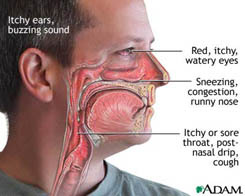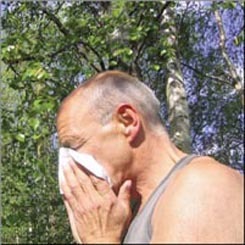
Allergies are caused by an over-sensitive immune response. The immune system normally protects the body against harmful substances such as bacteria and viruses. Allergy symptoms occurs when the immune system reacts to substances (allergens) that are generally harmless and in most people do not cause an immune response.
When a person with allergies breathes in an allergen such as pollen or dust, antibodies are produced. When the antibodies are stimulated by pollen and dust, histamine and other chemicals are released. This causes itching, swelling, and mucus production. Symptoms vary from person to person. Very sensitive individuals can experience hives or other rashes.
Hay fever involves an allergic reaction to pollen. A similar reaction occurs with allergy to mold, animal dander, dust, and similar inhaled allergens.
The pollens that cause hay fever vary from person to person and from region to region. Large, visible pollens are seldom responsible for hay fever. Tiny, hard to see pollens more often cause hay fever. Examples of plants commonly responsible for hay fever include:
- Trees (deciduous and evergreen)
- Grasses
- Ragweed
The amount of pollen in the air can play a role in whether hay fever symptoms develop. Hot, dry, windy days are more likely to have increased amounts of pollen in the air than cool, damp, rainy days when most pollen is washed to the ground.
Some disorders may be associated with allergies. These include eczema and asthma.
Allergies are common. Your genes and environmental may make you more prone to allergies.
Hay Fever Treatment
The goal of treatment is to reduce allergy symptoms caused by the inflammation of affected tissues.
The best "treatment" is to avoid what causes your allergic symptoms in the first place. It may be impossible to completely avoid all allergens to which you are sensitive, but you can often take steps to reduce exposure.
Medication options include the following:
- Short-acting antihistamines can relieve mild to moderate symptoms, but can cause drowsiness. Many may be bought without a prescription. A pediatrician should be consulted before using these medicines in children, as they may affect learning. Loratadine (Claritin) is now available over the counter. It does not tend to cause drowsiness or affect learning in children.
- Longer-acting antihistamines are available by prescription. They cause less drowsiness and can work just as well. They usually do not interfere with learning. These medications include fexofenadine (Allegra), and cetirizine (Zyrtec).
- Nasal corticosteroid sprays work very well for people with symptoms not relieved by antihistamines alone. These prescription medications include fluticasone (Flonase), mometasone (Nasonex), and triamcinolone (Nasacort).
- Azelastine (Astelin) is a new, nasal antihistamine that is used to treat allergic rhinitis.
- Decongestants may also be helpful in reducing symptoms such as nasal congestion, but they should not be used for long periods.
- Cromolyn sodium is a nasal spray (Nasalcrom) for treating hay fever. Eye drop versions of cromolyn sodium and antihistamines are available for itchy, bloodshot eyes.
- The leukotriene inhibitor Singulair is a prescription medicine approved to help control asthma and to help relieve the symptoms of seasonal allergies.

The most appropriate medication depends on the type and severity of symptoms. Specific illnesses that are caused by allergies (such as asthma and eczema) may require other treatments.
Allergy shots (immunotherapy) are occasionally recommended if the allergen cannot be avoided and if symptoms are hard to control. This includes regular injections of the allergen, given in increasing doses (each dose is slightly larger than the previous dose) that may help the body adjust to the antigen.
Herbal Treatment for Hay Fever
Yarrow - Achillea millefolium - Yarrow is used topically for wounds, cuts, and abrasions. An infusion of yarrow is known to speed recovery from sever bruising. Yarrow flowers are used for various allergic mucus problems, including hay fever.
 Print
Print Email
Email







